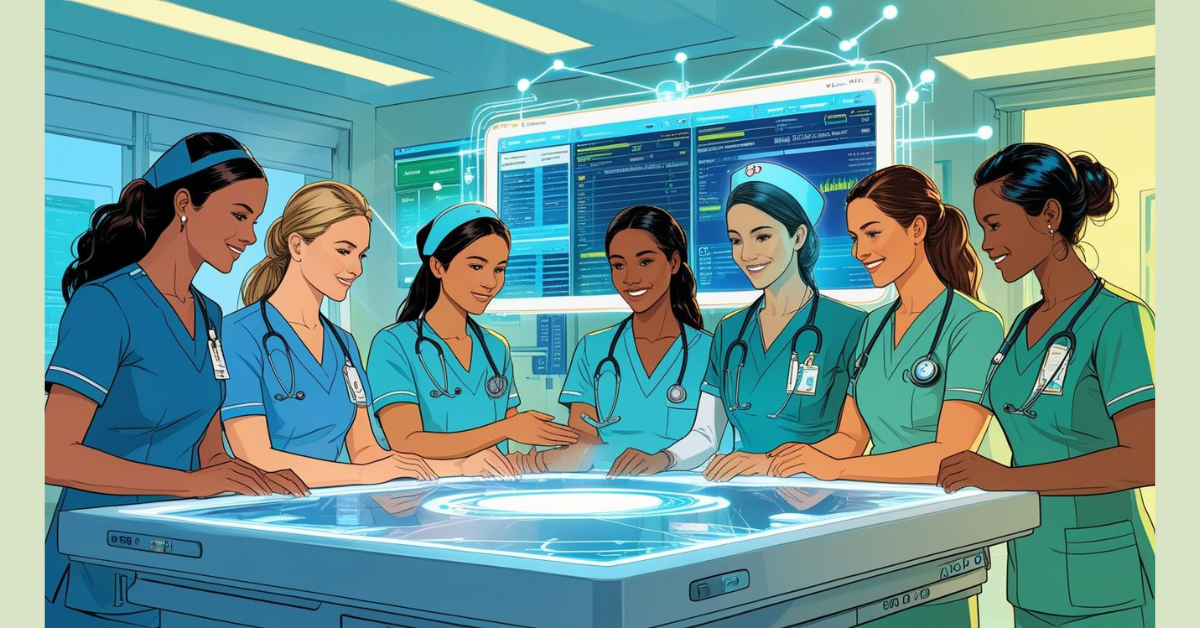The Critical Care Nursing and AI Implementations Transforming ICU Practice and Patient Outcomes. When examining nursing-sensitive outcomes, AI has shown potential to improve the identification, prevention, and management of patient.
Critical Care Nursing and AI Implementations Transforming ICU Practice and Patient Outcomes
Introduction
The integration of synthetic intelligence (AI) into crucial care nursing represents a paradigm shift in in depth care unit (ICU) practice. As healthcare structures global grapple with growing affected person complexity, staffing challenges, and the call for precision medicine, AI technology provide unparalleled possibilities to beautify affected person results whilst helping nursing experts of their crucial decision-making processes.
Current State of AI in Critical Care
Monitoring and Surveillance Systems
AI-powered tracking structures have revolutionized affected person surveillance in ICUs. These structures constantly examine extensive quantities of physiological data, including:
- Real-time crucial signal tracking with predictive analytics which could pick out deterioration styles hours earlier than conventional methods
- Sepsis prediction algorithms that examine more than one biomarkers and medical parameters to offer early caution structures
- Hemodynamic tracking with AI-assisted interpretation of complicated waveforms and stress measurements
- Respiratory tracking structures which could are expecting ventilator weaning readiness and optimize mechanical air flow parameters
Clinical Decision Support Systems
Modern AI implementations offer nurses with state-of-the-art choice assist gear that beautifies scientific judgment as opposed to update it. These structures examine affected person records to signify interventions, medicinal drug adjustments, and care protocols even as keeping the nurse`s important function in affected person advocacy and holistic care delivery.
Key AI Technologies Transforming ICU Practice
Machine Learning Algorithms
Machine studying fashions skilled on enormous datasets of ICU affected person data can become aware of diffused styles that would get away human observation. These algorithms excel at:
- Risk stratification for situations like acute kidney injury, cardiac arrest, and respiration failure
- Medication dosing optimization specifically for complicated capsules like insulin, sedatives, and vasopressors
- Length of live prediction to help discharge making plans and useful resource allocation
- Mortality hazard evaluation to manual goals-of-care conversations and own circle of relatives communication
Natural Language Processing (NLP)
NLP technology are reworking how nurses record and get right of entry to affected person statistics by:
- Automated documentation that reduces administrative burden even as keeping accuracy
- Clinical be aware evaluation that extracts key statistics from unstructured text
- Voice-activated structures that permit hands-loose documentation and statistics retrieval
- Real-time translation offerings for numerous affected person populations
Computer Vision and Image Analysis
AI-powered photograph evaluation is improving diagnostic skills thru:
- Chest X-ray interpretation with computerized detection of pneumonia, pneumothorax, and different conditions
- Wound evaluation the use of telephone cameras to music recovery progress
- Mobility tracking thru laptop imaginative and prescient structures that examine affected person motion and fall risk
- Medication verification the use of photograph popularity to save you management errors
Impact on Patient Outcomes
Improved Safety and Quality Metrics
Research demonstrates that AI implementations in crucial care settings result in measurable upgrades in affected person protection and first-class outcomes:
- Reduced clinical mistakes via automatic cross-checking and alert systems
- Decreased hospital-obtained infections through predictive modeling and early intervention protocols
- Lower mortality quotes in establishments with complete AI-assisted tracking systems
- Improved remedy protection via AI-powered drug interplay screening and dosing recommendations
Enhanced Care Coordination
AI structures facilitate higher verbal exchange and coordination amongst healthcare groups by:
- Automated handoff reviews that make sure essential data switch among shifts
- Care pathway optimization that coordinates interventions throughout a couple of disciplines
- Resource allocation algorithms that optimize staffing and system utilization
- Family verbal exchange gear that offer real-time updates on affected person progress
Transforming Nursing Practice
Workflow Enhancement
AI technology is reshaping nursing workflows in ICUs by:
- Prioritizing affected person desires thru computerized acuity scoring and undertaking scheduling
- Streamlining documentation with voice reputation and automatic statistics entry
- Optimizing medicinal drug management thru barcode scanning and automatic verification
- Enhancing affected person rounding with cellular gadgets that offer real-time get entry to to AI-generated insights
Skill Development and Education
The integration of AI in crucial care nursing necessitates ongoing training and talent development:
- Digital literacy education to assist nurses efficaciously use AI tools
- Critical questioning enhancement as nurses discover ways to interpret and act on AI-generated recommendations
- Data interpretation talents to recognize AI outputs and their scientific implications
- Technology troubleshooting abilities to preserve gadget functionality
Preserving Human Elements
While AI complements technical capabilities, essential care nurses continue to be important for:
- Emotional guide and mental take care of sufferers and families
- Clinical judgment in complicated conditions requiring human instinct and experience
- Ethical decision-making in end-of-existence care and useful resource allocation
- Patient advocacy making sure that generation serves affected person hobbies in preference to changing human compassion
Challenges and Considerations
Technical Challenges
- Data great and interoperability problems that may have an effect on AI device performance
- Alert fatigue from poorly calibrated structures producing immoderate fake alarms
- System integration demanding situations whilst imposing AI equipment throughout exclusive platforms
- Cybersecurity worries associated with affected person facts safety and device vulnerabilities
Ethical and Legal Considerations
- Liability questions concerning AI-assisted decision-making and affected person outcomes
- Bias in algorithms that could perpetuate healthcare disparities
- Privacy worries associated with non-stop tracking and records collection
- Informed consent demanding situations whilst AI structures make remedy recommendations
Workforce Implications
- Job displacement fears and the want for personnel retraining
- Resistance to alternate from healthcare experts cushy with conventional methods
- Cost issues for schooling and generation implementation
- Generational variations in generation adoption and luxury levels
Future Directions
Emerging Technologies
The destiny of AI in crucial care nursing will possibly include:
- Predictive analytics that may forecast affected person deterioration days in advance
- Personalized remedy algorithms that tailor remedies to person affected person characteristics
- Robotic help for recurring responsibilities like medicine transport and affected person positioning
- Augmented fact structures that overlay affected person statistics and care commands in real-time
Research Priorities
Ongoing studies focuses on:
- Algorithm transparency and explainable AI structures that nurses can apprehend and trust
- Outcome validation research that reveal the scientific effectiveness of AI implementations
- Cost-effectiveness evaluation of AI technology in vital care settings
- Human elements studies to optimize the interface among nurses and AI structures
Implementation Strategies
Successful Deployment Approaches
Healthcare establishments enforcing AI in essential care need to consider:
- Phased implementation beginning with pilot packages in choose units
- Stakeholder engagement regarding nurses in gadget layout and choice processes
- Comprehensive schooling packages that deal with each technical and medical aspects
- Continuous tracking and adjustment of AI structures primarily based totally on consumer comments and outcomes
Best Practices
- Interdisciplinary collaboration among nursing, medicine, and statistics era teams
- Change control techniques that deal with resistance and sell adoption
- Quality warranty approaches to make certain AI structures hold accuracy and reliability
- Regular updates and preservation to maintain structures modern-day with evolving scientific practice
Conclusion
The integration of AI technology into essential care nursing represents a transformative possibility to decorate affected person effects at the same time as assisting nursing specialists of their critical work. Success calls for considerate implementation that preserves the human factors of nursing care at the same time as leveraging technology`s talents to enhance safety, efficiency, and scientific decision-making.
As the sphere keeps evolving, essential care nurses have to continue to be lively contributors in shaping how AI technology are developed, implemented, and applied in ICU settings. By embracing those improvements at the same time as preserving their dedication to affected person-targeted care, nurses can make certain that AI serves as a effective device for enhancing essential care effects in preference to changing the irreplaceable human factors of nursing practice.
The destiny of essential care nursing lies now no longer in selecting among human know-how and synthetic intelligence, however in developing synergistic partnerships that expand the strengths of each to supply unparalleled stages of affected person care with inside the in depth care environment.
Read More:
https://nurseseducator.com/didactic-and-dialectic-teaching-rationale-for-team-based-learning/
https://nurseseducator.com/high-fidelity-simulation-use-in-nursing-education/
First NCLEX Exam Center In Pakistan From Lahore (Mall of Lahore) to the Global Nursing
Categories of Journals: W, X, Y and Z Category Journal In Nursing Education
AI in Healthcare Content Creation: A Double-Edged Sword and Scary
Social Links:
https://www.facebook.com/nurseseducator/
https://www.instagram.com/nurseseducator/
https://www.pinterest.com/NursesEducator/
https://www.linkedin.com/in/nurseseducator/
https://www.researchgate.net/profile/Afza-Lal-Din
https://scholar.google.com/citations?hl=en&user=F0XY9vQAAAAJ



https://ufo.hosting/
https://the.hosting/bg/help/security/
motoryacht chartern
https://www.bark.com/en/gb/company/findycar-nl/3OdXeK/
You are absolutely right. In it something is also to me it seems it is very excellent idea. Completely with you I will agree.